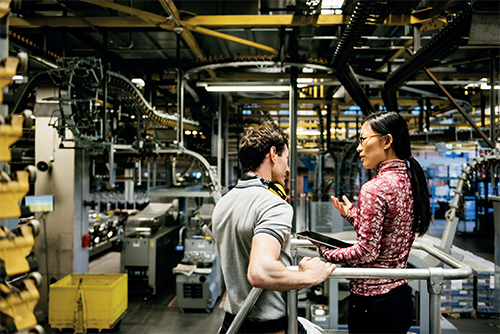
Working together
There is no dispute the manufacturing industry is vital to the UK economy. According to one report it has an annual output value of £192 billion, making the UK the ninth largest manufacturing country in the world and the British Government has underlined manufacturing is integral to its vision of ‘Global Britain.’
However, the threats facing the industry are also very real. The pandemic shock has been severe with Make UK estimating the sector lost roughly £18 billion in value between 2019 – 2020 and it will take until 2022 to return output to pre-pandemic levels. There are positive signs of growth in the most recent forecasts from the Manufacturing Purchasing Managers Index (PMI) making the performance so far this year the strongest since 1992 and Make UK has also upped its expectation for growth from 3.8 percent to 7.8 percent. This does offer hope, but Covid-19 has also brought the longer-term strategic challenges facing the manufacturing industry into sharp relief. Both the pandemic and Ever Given blocking the Suez have underlined the dangers of relying on stretched supply-chains and distant suppliers. It is no surprise that another report from Make UK estimates 31 percent of small companies and 65 percent of large companies are dependent on sourcing components from China or other affected countries.
This reliance on distant suppliers also points to another priority facing the industry as it seeks to meet the UK Government’s ambitious carbon reduction goals. Clearly, near-shoring materials and components could significantly reduce the carbon footprint for production, but it does come with challenges. Add to this, the Manufacturing Made Smarter Challenge aims to raise productivity by 30 percent by 2030 and manufacturers in this country face some of the most complex strategic decisions they have ever faced.
Digital transformation is key, but should not be considered in isolation
We recently sponsored a survey of global CFOs and 81 percent of finance chiefs in the manufacturing industry very clearly stated that digital transformation initiatives are key to their success. This is significantly higher than the global average of 71 percent. What this means is that the CIO is going to come under significant scrutiny to deliver such modernization. This should not mean, though, that the priorities of the IT department are more important than those of any other business function. The challenges ahead in finance clearly show that there are  significant financial and operational strategy questions to be addressed alongside IT modernization.
significant financial and operational strategy questions to be addressed alongside IT modernization.
Having worked with many CFOs and CIOs in the manufacturing industry, I would argue that the strength of the relationship between these key functions will determine future success. Indeed, in our study 62 percent of manufacturing CFOs say the relationship with their CIOs has improved during the pandemic, which contrasts with only 49 percent of retail CFOs saying the same thing. Perhaps one good thing that can come from this crisis is that it will focus minds and encourage far greater collaboration as these previously siloed functions recognize survival depends on co-operation.
The long-term challenge: Lifetime cost of purchase
The co-operation is critical due to how intertwined their decision-making will be moving forward. If digital transformation is central to the future success of manufacturers there are significant costs to be weighed up. For example, while near-shoring might address supply-chain security it could mean the cost of production becomes prohibitively expensive, driven by competition for quality materials and access to skills. Addressing carbon emissions will require significant investment, but with the demand for raw materials putting pressure on margins it will be difficult to find the funds for investment.
Between them, CIOs and CFOs must balance these considerations, which ultimately comes down to how they measure the lifetime cost of the manufacture and purchase of goods. The evaluation of the costs built into the production process and what that means in terms of the cost passed on to customers, has become more difficult and is being redefined on an almost daily basis. CIOs must be sensitive to the pressures facing finance chiefs as they present their case for digital transformation. Another reason why partnership between CFOs and CIOs is crucial.
Transforming your way out of trouble
The expectation is that IT will enable manufacturers to transform their way out of trouble. CIOs must be careful not to overpromise and under deliver in these circumstances. One way to ensure effective IT planning is by integrating it into the discussion about the lifetime cost of manufacture and purchase.
Transformation can take many forms. For example, Arrival is being held up as a beacon of the concept of ‘micro-factories’ where operations are far leaner than historically, while at the other extreme individuals like Elon Musk seem to only talk about ‘gigafactories’. And despite the supply-chain risks, China is not going to go away any time soon as a key supplier to manufacturers. Whatever the strategy, it must be paid for, and as highlighted earlier, pressure margin means it could be hard to find the resources to invest in innovation, so CIOs and CFOs must work together to avoid costs spiraling.
Reports suggest manufacturers are also reluctant to borrow to fund transformation, which is understandable, but it means UK manufacturers will have to redirect funds from elsewhere in the organization to support transformation. How do you decide where to drive cost reductions so that you can reinvest in innovation without compromising production?
In our study, one concern raised was the time it would take to see a return-on-investment (ROI). Manufacturing CFOs suggest it will take three to five years, contrasted with retail CIOs who suggest it will only take one to two years. When manufacturing CFOs say the relationship with their CIOs has broken down, our study suggests it is because the CIO lacks a sense of urgency and does not welcome the CFO pro-actively engaging. This is where the partnership between CFOs and CIOs is crucial. For the CFOs who say they have strengthened the relationship with their CIOs, they have done so due to an urgent need to collaborate to make nimble technology decisions.
If CIOs are to respond to this sense of urgency and finance chiefs are to properly evaluate the financial implications of significantly evolving the lifetime cost of purchase, it is absolutely essential these two functions become joined at the hip. While the complexity is challenging, it is clear that UK manufacturers are positive about the potential for growth and with the right integrated IT and finance strategy they will have robust foundations to support their long-term ambitions.
For a list of sources used within this article, please contact the editor.
Emmanuelle Hose
 Emmanuelle Hose is Group Vice President and General Manager EMEA, at Rimini Street, a global provider of enterprise software products and services, the leading third-party support provider for Oracle and SAP software products and a Salesforce partner. The company offers premium, ultra-responsive and integrated application management and support services that enable enterprise software licensees to save significant costs, free up resources for innovation and achieve better business outcomes. To date, more than 4,000 Fortune 500, Fortune Global 100, midmarket, public sector and other organizations from a broad range of industries have relied on Rimini Street as their trusted application enterprise software products and services provider.
Emmanuelle Hose is Group Vice President and General Manager EMEA, at Rimini Street, a global provider of enterprise software products and services, the leading third-party support provider for Oracle and SAP software products and a Salesforce partner. The company offers premium, ultra-responsive and integrated application management and support services that enable enterprise software licensees to save significant costs, free up resources for innovation and achieve better business outcomes. To date, more than 4,000 Fortune 500, Fortune Global 100, midmarket, public sector and other organizations from a broad range of industries have relied on Rimini Street as their trusted application enterprise software products and services provider.
www.riministreet.com